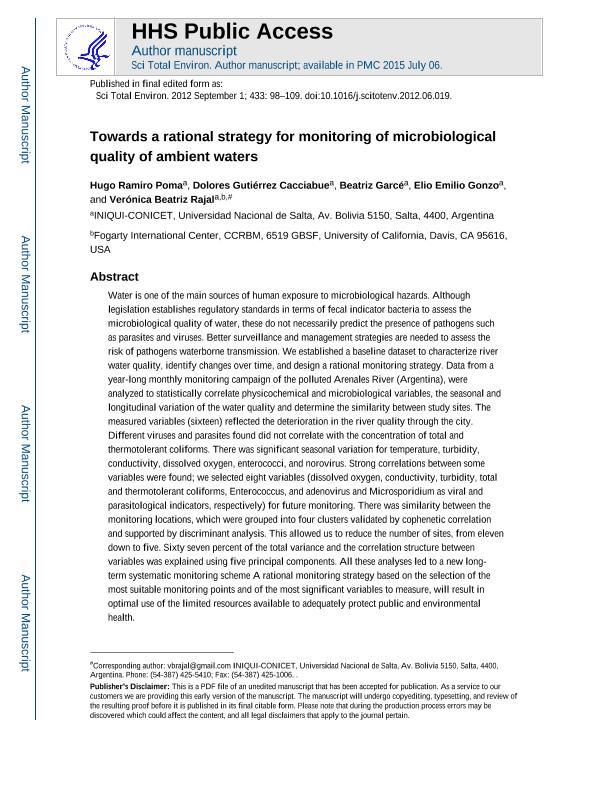Mostrar el registro sencillo del ítem
dc.contributor.author
Poma, Hugo Ramiro

dc.contributor.author
Gutiérrez Cacciabue, Dolores

dc.contributor.author
Garces, Alicia Beatriz

dc.contributor.author
Gonzo, Elio Emilio

dc.contributor.author
Rajal, Verónica Beatriz

dc.date.available
2020-10-23T17:12:29Z
dc.date.issued
2012-06
dc.identifier.citation
Poma, Hugo Ramiro; Gutiérrez Cacciabue, Dolores; Garces, Alicia Beatriz; Gonzo, Elio Emilio; Rajal, Verónica Beatriz; Towards a rational strategy for monitoring of microbiological quality of ambient waters; Elsevier Science; Science of the Total Environment; 433; 6-2012; 98-109
dc.identifier.issn
0048-9697
dc.identifier.uri
http://hdl.handle.net/11336/116745
dc.description.abstract
Water is one of the main sources of human exposure to microbiological hazards. Although legislation establishes regulatory standards in terms of fecal indicator bacteria to assess the microbiological quality of water, these do not necessarily predict the presence of pathogens such as parasites and viruses. Better surveillance and management strategies are needed to assess the risk of pathogens waterborne transmission. We established a baseline dataset to characterize river water quality, identify changes over time, and design a rational monitoring strategy. Data from a year-long monthly monitoring campaign of the polluted Arenales River (Argentina), were analyzed to statistically correlate physicochemical and microbiological variables, the seasonal and longitudinal variation of the water quality and determine the similarity between study sites. The measured variables (sixteen) reflected the deterioration in the river quality through the city. Different viruses and parasites found did not correlate with the concentration of total and thermotolerant coliforms. There was significant seasonal variation for temperature, turbidity, conductivity, dissolved oxygen, enterococci, and norovirus. Strong correlations between some variables were found; we selected eight variables (dissolved oxygen, conductivity, turbidity, total and thermotolerant coliforms, Enterococcus, and adenovirus and Microsporidium as viral and parasitological indicators, respectively) for future monitoring. There was similarity between the monitoring locations, which were grouped into four clusters validated by cophenetic correlation and supported by discriminant analysis. This allowed us to reduce the number of sites, from eleven down to five. Sixty seven percent of the total variance and the correlation structure between variables was explained using five principal components. All these analyses led to a new long-term systematic monitoring scheme A rational monitoring strategy based on the selection of the most suitable monitoring points and of the most significant variables to measure, will result in optimal use of the limited resources available to adequately protect public and environmental health.
dc.format
application/pdf
dc.language.iso
eng
dc.publisher
Elsevier Science

dc.rights
info:eu-repo/semantics/openAccess
dc.rights.uri
https://creativecommons.org/licenses/by-nc-sa/2.5/ar/
dc.subject
ENTERIC VIRUS
dc.subject
MICROBIAL INDICATOR
dc.subject
PARASITE
dc.subject
PP7
dc.subject
SURVEILLANCE STRATEGY
dc.subject
WATER QUALITY
dc.subject.classification
Otras Ingeniería del Medio Ambiente

dc.subject.classification
Ingeniería del Medio Ambiente

dc.subject.classification
INGENIERÍAS Y TECNOLOGÍAS

dc.title
Towards a rational strategy for monitoring of microbiological quality of ambient waters
dc.type
info:eu-repo/semantics/article
dc.type
info:ar-repo/semantics/artículo
dc.type
info:eu-repo/semantics/publishedVersion
dc.date.updated
2020-02-13T19:56:04Z
dc.journal.volume
433
dc.journal.pagination
98-109
dc.journal.pais
Países Bajos

dc.journal.ciudad
Amsterdam
dc.description.fil
Fil: Poma, Hugo Ramiro. Consejo Nacional de Investigaciones Científicas y Técnicas. Centro Científico Tecnológico Conicet - Salta. Instituto de Investigaciones para la Industria Química. Universidad Nacional de Salta. Facultad de Ingeniería. Instituto de Investigaciones para la Industria Química; Argentina
dc.description.fil
Fil: Gutiérrez Cacciabue, Dolores. Consejo Nacional de Investigaciones Científicas y Técnicas. Centro Científico Tecnológico Conicet - Salta. Instituto de Investigaciones para la Industria Química. Universidad Nacional de Salta. Facultad de Ingeniería. Instituto de Investigaciones para la Industria Química; Argentina
dc.description.fil
Fil: Garces, Alicia Beatriz. Consejo Nacional de Investigaciones Científicas y Técnicas. Centro Científico Tecnológico Conicet - Salta. Instituto de Investigaciones para la Industria Química. Universidad Nacional de Salta. Facultad de Ingeniería. Instituto de Investigaciones para la Industria Química; Argentina
dc.description.fil
Fil: Gonzo, Elio Emilio. Consejo Nacional de Investigaciones Científicas y Técnicas. Centro Científico Tecnológico Conicet - Salta. Instituto de Investigaciones para la Industria Química. Universidad Nacional de Salta. Facultad de Ingeniería. Instituto de Investigaciones para la Industria Química; Argentina
dc.description.fil
Fil: Rajal, Verónica Beatriz. Consejo Nacional de Investigaciones Científicas y Técnicas. Centro Científico Tecnológico Conicet - Salta. Instituto de Investigaciones para la Industria Química. Universidad Nacional de Salta. Facultad de Ingeniería. Instituto de Investigaciones para la Industria Química; Argentina. University of California; Estados Unidos
dc.journal.title
Science of the Total Environment

dc.relation.alternativeid
info:eu-repo/semantics/altIdentifier/doi/http://dx.doi.org/10.1016/j.scitotenv.2012.06.019
dc.relation.alternativeid
info:eu-repo/semantics/altIdentifier/url/https://www.sciencedirect.com/science/article/abs/pii/S0048969712008340
dc.relation.alternativeid
info:eu-repo/semantics/altIdentifier/url/https://www.ncbi.nlm.nih.gov/pmc/articles/PMC4492939/
Archivos asociados
